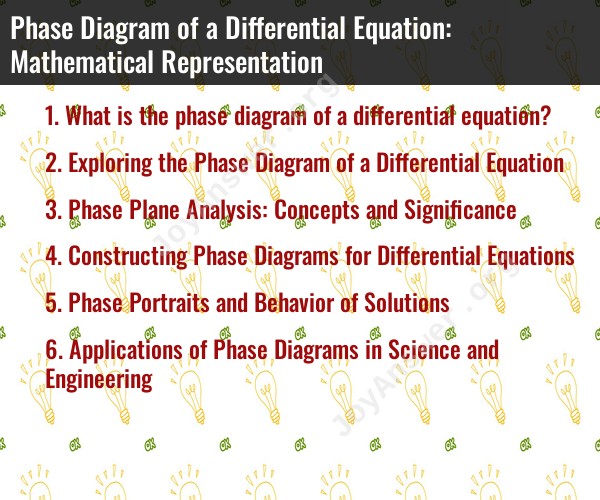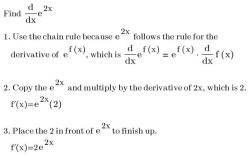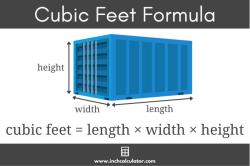What is the phase diagram of a differential equation?
A phase diagram, also known as a phase portrait, is a graphical representation of the solutions or trajectories of a system of ordinary differential equations (ODEs). It is a valuable tool in the study of dynamical systems and provides insights into the behavior of the system over time. A phase diagram typically involves plotting solutions in a phase space, which is a multi-dimensional space that represents the state variables of the system.
Here's how to understand and create a phase diagram for a differential equation:
State Variables: In a system of differential equations, you have state variables that describe the system's state at a given time. For example, in a simple mechanical system, you might have position and velocity as state variables.
Differential Equations: The system is governed by one or more differential equations that describe how the state variables change over time. These equations can be first-order, second-order, or higher-order, depending on the complexity of the system.
Phase Space: The phase space is created by choosing one of the state variables as the x-axis and another as the y-axis (for two-dimensional systems). The number of dimensions in the phase space depends on the number of state variables. For a simple two-variable system, you'd have a two-dimensional phase space.
Trajectories: Each solution to the differential equations represents a trajectory in the phase space. These trajectories can be curves, loops, or other patterns, depending on the nature of the system.
Steady States: Steady states or equilibrium points are important in the phase diagram. These are points where the system remains unchanged over time. In the phase space, these points are typically where trajectories converge or spiral around.
Direction Fields: Direction fields are used to indicate the direction of the solutions at different points in the phase space. Arrows or vectors are often drawn to show how the solutions evolve from one point to another.
Analysis: By examining the phase diagram, you can gain insights into the long-term behavior of the system. You can determine whether the system converges to a steady state, exhibits oscillations, or displays chaotic behavior.
Stability Analysis: The behavior near steady states is often analyzed to determine whether they are stable or unstable. Stable steady states attract nearby trajectories, while unstable steady states repel them.
Bifurcations: The phase diagram can reveal bifurcation points where the behavior of the system changes qualitatively as system parameters are varied.
Phase diagrams are commonly used in physics, engineering, biology, and various other fields to study the dynamics of complex systems. They help researchers and scientists understand how systems evolve and make predictions about their long-term behavior without solving the differential equations explicitly.
Exploring the Phase Diagram of a Differential Equation
A phase diagram is a graphical representation of the different equilibrium states and their behaviors of a dynamical system, such as a differential equation. It is a powerful tool for understanding the qualitative behavior of solutions to differential equations.
Phase Plane Analysis: Concepts and Significance
Phase plane analysis is a method of analyzing dynamical systems by plotting the solutions in a phase plane. The phase plane is a two-dimensional space in which the horizontal axis represents one variable and the vertical axis represents another variable. The solutions to the differential equation are plotted as trajectories in the phase plane.
Phase plane analysis is significant because it allows us to visualize the behavior of solutions to differential equations. We can see how the solutions evolve over time and how they interact with each other. We can also identify equilibrium states and their stability.
Constructing Phase Diagrams for Differential Equations
To construct a phase diagram for a differential equation, we need to first identify the equilibrium states of the system. An equilibrium state is a point in the phase plane where the solutions do not change over time.
Once we have identified the equilibrium states, we need to determine their stability. A stable equilibrium state is a point in the phase plane where solutions that start near the equilibrium state will remain near the equilibrium state over time. An unstable equilibrium state is a point in the phase plane where solutions that start near the equilibrium state will move away from the equilibrium state over time.
Finally, we need to sketch the trajectories in the phase plane. We can do this by using the direction field for the differential equation. The direction field is a vector field that shows the direction of the solutions at each point in the phase plane.
Phase Portraits and Behavior of Solutions
A phase portrait is a graphical representation of the trajectories of a dynamical system in the phase plane. The phase portrait can provide us with a lot of information about the behavior of the solutions to the differential equation.
For example, the phase portrait can show us whether the solutions are stable or unstable, whether they converge to an equilibrium state, or whether they oscillate between two equilibrium states.
Applications of Phase Diagrams in Science and Engineering
Phase diagrams are used in a wide variety of fields, including science and engineering. Some examples of applications of phase diagrams include:
- Modeling the behavior of chemical reactions
- Predicting the stability of aircraft and spacecraft
- Analyzing the spread of diseases
- Designing control systems for robots and other machines
Conclusion
Phase diagrams are a powerful tool for understanding and analyzing dynamical systems. They can be used to visualize the behavior of solutions to differential equations, identify equilibrium states and their stability, and sketch trajectories in the phase plane. Phase diagrams are used in a wide variety of fields, including science and engineering.













